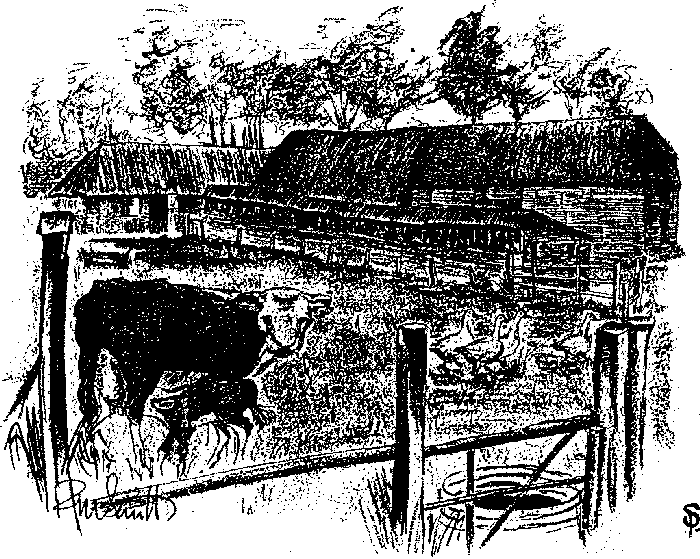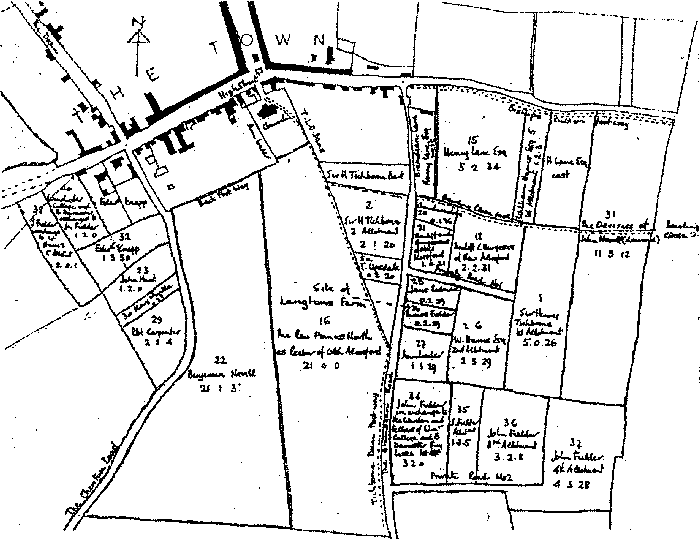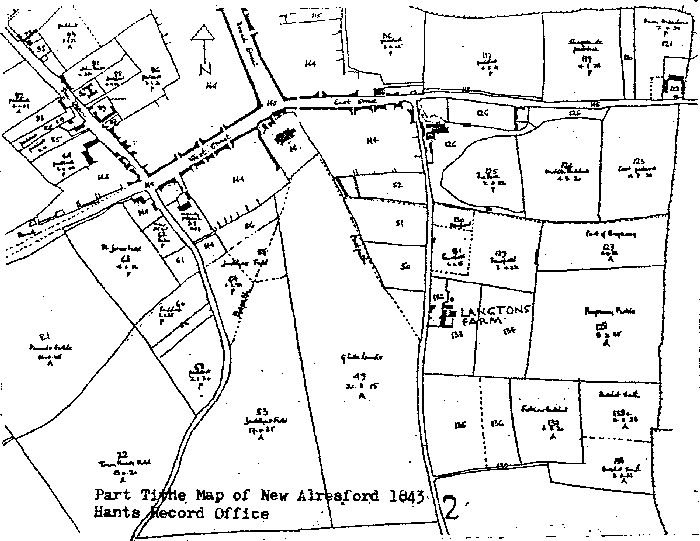LANGTONS FARM
By
Pamela Conway

Some residents of Alresford regarded the dilapidated farm buildings in Sun Lane as a blot on the landscape, others felt nostalgia for the past, but the change this year (1990) is the inevitable result when farm buildings become redundant due to modern agricultural techniques together with the pressing need for new houses, to name only two reasons.
It was in the year 1771 that a new residence was built on the corner of Bramdean Wey (now Sun Lane) and the Bishops Sutton roadway in New Alresford. The site was the western end of Marditch (or Barditch) furlong that had been continuously cultivated since it had been formed by the Bishop de Lucy in the early years of the thirteenth century; the small house was sheltered behind the brick boundary wall to the Bramdean Wey which is marked by the date of 1771 in blue brick headers built in to the western face. Dr. Isabel Sanderson, in her fourth book of 'Dwellings in Alresford' carefully traces for us the history and occupants of the house first known as 'East End Close' and then 'Langtons House'. 'But how did 'Langtons Farm' situated close to the southern boundary emerge?
The Enclosure Award of 1807 had a great effect on Alresford. The ancient furlong strip cultivation disappeared completely, to be replaced with a collection of large and small fields. In this, a group of small fields was established on the southern boundary of Langton House - see Sketch 1. And in 1855 these small fields, owned by the Bailiff and Burgesses and the Churchwardens, now grouped together and known as the 'Fairfield' were to be used to accommodate the many sheep fairs held in each year. A new building had been erected to house the hurdles required for the penning.

Part Enclosure Map of New Alresford 1:+7
- Hants Record Office
Later the Tithe Award of 1843 clearly indicates on the Award Map that a new farmhouse had been established, complete with its outbuildings before this date. However, we find from the Award that the farm was owned by William Goodrich and occupied by George Webb, together with some ninety acres of arable and pasture land mostly on the southern fields of Alresford - Sketch 2. Of these fields, Nos 40 and 119 were leased to William Goodrich by the Wardens of the College of Winchester nearby. Also the new Rectory, built on the Glebe land frontage to Bramdean Wey in 1850, on the separation of New Alresford parish from the Mother church of Old Alresford when it became a distinct benefice in its own right, was required as the residence for the first Rector, the Rev. William Brodie.
Twenty years later the coming of the railway again had a great effect on this part of Alresford; the sheep fairs were removed from the Fairfield to College owned land in Sutton Road previously occupied by George Webb, and the deep cutting then constructed for the railway line which was completed in 1865. The Glebe land was also severed for the construction of the new station and railway yard and thus the new, Rectory became cut off from the parish church.
Later, in the mid-1890s 'Langton House' was purchased by Lt. Col. Stratton Bates on his retirement to Alresford, and soon after taking possession he also bought the established dairy farm nearby, which now consisted of some twenty acres only. The farm had been managed by Mark King, a dairyman living in East Street since 1880, and nineteen years later he moved into the farm house, now known as Lodge Farm. By 1911 the dairyman was Thomas Hunt, followed by Mr. Clark in 1920, who is described as a 'farmer and dairyman living at Langtons Farm'. There was a narrow field on the north side of the farmhouse (where Mr. Conway's bungalow now stands) and at the top of this field a small gate led to a tennis court; over the years this fell into disuse and the land was later incorporated into the field beyond,

In 1926 Herbert Charles Godwin purchased Langtons Farm and lived there with his family until 1939. His daughter, Miss Amelia Frances Godwin, who has now returned to Alresford for her retirement, recalls many vivid memories of her childhood at Langtons Farm. She recalls that apart from the lands adjoining the farm, others were rented from the church. These fields opposite the farmhouse, being part of the ancient Glebe lands, were now called the 'Rectory Fields' and stretched up behind the Rectory and part way across to Jacklyns Lane. Tithes were paid for these fields. Beyond them, reaching to Jacklyns Lane, was a field owned by the grocer, Mr. Ellingham, where he kept his horse; it later became a nursery which was run by Mr. George Wells, now also retired to Alresford.
In the hedge at the back of the Rectory there was a wicket gate opening on to the fields and the Rector, the Rev. A.J. Robertson, used to walk across the fields to the station where there was a stile in the fence giving access to the platform. On one occasion, when the army was on manoeuvres, they bivouaced in the Rectory fields overnight.The fields were full of little tents, tethered horses and mules, field kitchens and troops. They made quite a sight marching along Sun Lane.
More land where cows and young heifers
were to graze, being situated opposite
to Edward Terrace, was rented from
Col. Chapman then residing at Langton
Lodge. This field was known as 'The
Park' and the railings are still
there. The field adjoining 'Cardew'
in Sutton Road, together with two
fields backing on to Old Alresford
pond were also rented from Sir William
Makins, for use as additional pasturage.
It was common practice at this time
for rent not to be charged; in its
place the landowners would ask for
payment in kind. For instance, Col.
Chapman would ask for three or four
loads of manure per year and Sir
William Makins purchased a cow which
was milked by the farmer. It was
a familiar sight to see his butler
walk from Langton House to the farm
every morning with his can to collect
the day’s
supply of milk for the House.
During the 1920's Langtons Farm
thrived. A mixed herd of cows was
kept, some Guernsey and some Shorthorn,
and there was always a Guernsey
bull. In addition to the arable
crops there were some 200 chickens
and 'ducks and up to 100 pigs,
two carthorses and a pony for the
milk float. A familiar sight in
Sun Lane was the constant movement
of the dairy herd from one field
to another and also the cart horse
being led down Sun Lane to be shod
in the Forge in Broad Street. And
many of the residents of Tichborne
Down House Hospital would be employed
to assist the farmer during the
busy harvest and haymaking periods.
The milk van delivered daily from
the dairy (together with some from
the well known Guernsey herd at
Tichborne) for the round which
covered Alresford, Bishops Sutton
and Old Alresford. The dairy building,
called the 'Devonshire Dairy' stood
at the back of the house covered
all over with Virginia Creeper to
assist in keeping it cool and shady;
and inside the marble topped shelves
supported the bowls of rich clotted
cream. The bowls were also suspended
in boiling water, in a copper, to
make the cream after the milk had
been separated. Butter was also made
in the butter tub turned by hand.
After the butter milk had been pressed
out the butter was patted into shape
with wooden pats and weighed into
one pound blocks with a ridged pattern
put on the top. In Mr. Clark's time
cheese was also made on the premises.
Besides the barn and the stable, there were cowpens and a cart shed in the farmyard backing on to Sun Lane. There used to be a small building, now demolished, in the front garden adjoining the cart shed which was the cooling house for the milk cooler. Milk was brought up here from the cowshed in pails, the cowman carrying two pails at a time with a yoke held across his shoulders. The milk was cooled as it ran over the machine made cold by water from the inside well.
The farm was part arable, root crops, wheat and oats also being grown and part pasture. The corn was cut by a binder drawn by the two cart horses, and stooked, and then the hay and corn would be made into ricks built in the rickyard at the head of the big barn. Later, the threshing machine would arrive and the sheaves would be fed into it and a new rick made from the straw. As the last sheaves of the old rick were removed the rats would scamper out, but not many escaped. A cow man and a carter were employed, together with extra help, at haymaking and harvest time, when usually several sheaves of corn would be sent to the church to help form part of the traditional harvest festival decorations.
In 1947 Bernard Conway acquired Langtons Farm which then comprised approximately thirty acres. He purchased further parcels of land to the east of Sun Lane, bringing the total acreage to eighty four. The majority of the land is now owned by Mr. Roger Pearson and the house - renamed Langton Farmhouse - is owned by Mr. Cheshire.
Under the provisions of the New Alresford Town Plan of 1964 the land to the west of Sun Lane was gradually acquired for residential development and Langtons Farm became no longer a viable unit as the space for farming rapidly diminished. In 1967 the land adjoining the farm itself was sold, leaving only the farmhouse and buildings. Bernard Conway died in 1967 leaving his widow still living in the house. After the sale of the house in 1977 the original farm was then under three ownerships - Langtons Farmhouse, the farm buildings and the surrounding land. Between 1977 and 1988 the farm buildings continued to be used in part for farming activities but permission was also given to three local businesses to use them.
Finally planning permission was sought and granted for residential development, and Langtons Court now stands on the site of the farm buildings. It must be remembered that this site was included for development in the Winchester Area Local Plan which was adopted in 1987. The demolition of the old farm buildings removed a land mark in Alresford which had been in existence for many, many years. The building now used as a garage in conjunction with Langtons Farmhouse was the former stable and is the only remaining 'farm building'. The removal of the farm was due also, at least in part, to its site being in close proximity to the centre of Alresford with all the convenience such a position provides. And now anxiety remains amongst some residents of the Town - will this leap across Sun Lane be the spearhead of further encroachment in the triangle formed by the bypass, the B3047 road and the village of Bishop's Sutton?
Copyright Pamela Conway October 1990
Sources :
Hampshire Record Office - Enclosure Map and Award 1807
Tithe Map and Award 1843
Census Returns for New Alresford Isabel Sanderson - Dwellings in Alresford No. 4
Amelia Frances Godwin - Reminiscences of Alresford
Also - Hampshire Directories
Various conveyances
Miscellaneous private papers